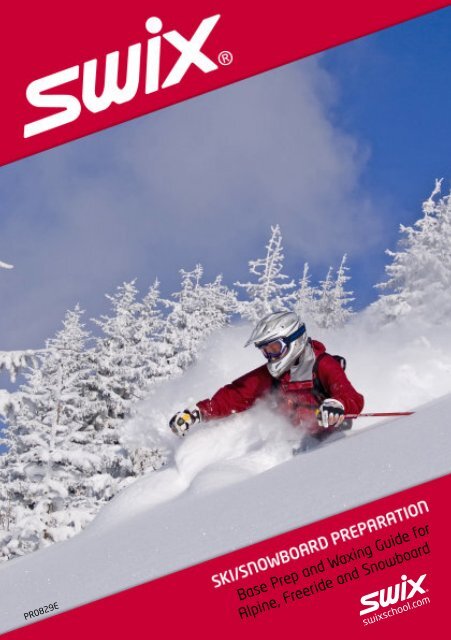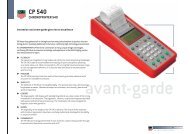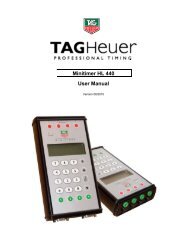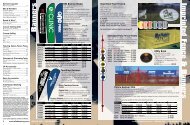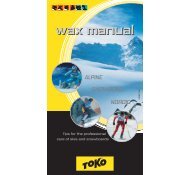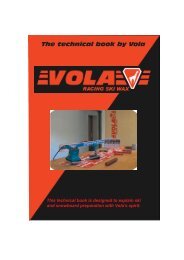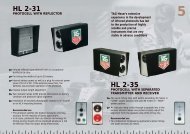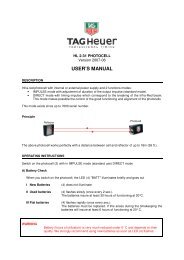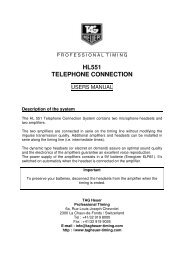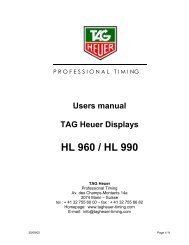swix sport - ski/snowboard preparation - Reliable Racing
swix sport - ski/snowboard preparation - Reliable Racing
swix sport - ski/snowboard preparation - Reliable Racing
You also want an ePaper? Increase the reach of your titles
YUMPU automatically turns print PDFs into web optimized ePapers that Google loves.
PR0829E<br />
Base Prep and Waxing Guide for<br />
Alpine, Freeride and Snowboard
Alpine <strong>ski</strong> and <strong>snowboard</strong> <strong>preparation</strong><br />
PERFORMANCE USER LEVEL<br />
This is the level for alpine <strong>ski</strong>ers and <strong>snowboard</strong>ers who use their equipment often and want to get the most<br />
out of their equipment. The focus is on achieving “the optimal feel”.<br />
STEEL EDGE AND BASE TREATMENT WITH SWIX PRODUCTS<br />
In a few simple steps, you can prep your <strong>ski</strong>s or <strong>snowboard</strong> to gain higher performance from your equipment.<br />
These simple steps can help you improve the glide and turning properties of your equipment significantly,<br />
and should also give you greater confidence that your equipment will optimise your <strong>ski</strong>ing experience.<br />
The greatest benefits come when <strong>ski</strong>ing on hard surfaces.<br />
T149-50 Alpine Ski Vise<br />
New <strong>ski</strong>s and <strong>snowboard</strong>s<br />
New <strong>ski</strong>s and <strong>snowboard</strong>s that have not been pretreated<br />
at the shop should be given a base treatment<br />
before use. A base treatment ensures the best<br />
possible starting point for the original surface coating<br />
and improves glide properties. The edges should<br />
also be sharpened in order to ensure the best<br />
possible carving properties on snow and ice.<br />
Sharpened steel edges provide you with better<br />
control and feel when turning, and is like putting<br />
new tires on your car – the equipment will be more<br />
responsive and tuned to your body, and you will<br />
gain more confidence in your <strong>ski</strong>ing abilities.<br />
When prepping <strong>ski</strong>s and <strong>snowboard</strong>s, a vise will help<br />
you work more easily and efficiently. We recommend<br />
T149-50 for alpine <strong>ski</strong>s and SB31 for <strong>snowboard</strong>.<br />
For alpine <strong>ski</strong>s retract the <strong>ski</strong> brakes with the T165<br />
Brake Retainer.<br />
SB31 Snowboard Vise<br />
T165 Ski Brake Retainer<br />
ADVICE:<br />
When treating the surface and steel edges,<br />
always start by prepping the edges first, which will<br />
ensure that you avoid getting wax on the filing tools.<br />
When the <strong>ski</strong> or <strong>snowboard</strong> is new, start the<br />
<strong>preparation</strong> by establishing the edge geometry<br />
(edge bevels). The key to obtaining optimal carving<br />
properties on snow and ice is to ensure that the<br />
edges are as smooth and even as possible.<br />
R392 Ski Straps with base protector<br />
2 SWIX SPORT - SKI/SNOWBOARD PREPARATION
Three important areas when prepping edges<br />
• Base edge<br />
• Side edge<br />
• Sidewall (Edge offset)<br />
BASE EDGE:<br />
1.0°<br />
0.5°<br />
Sidewall<br />
Ski/Snowboard<br />
Steel edge<br />
Base material<br />
Generally 0.5 to 1 degree bevel<br />
1. Base edge:<br />
• Make sure that the base edge is level with the base<br />
surface. Scraping the base surface is more difficult if<br />
the edges are too high, and this may also cause<br />
problems steering (erradic “hooking” effect).<br />
By beveling the base edge 1 degree, the edges will<br />
not grab immediately when you are <strong>ski</strong>ing, but you<br />
will gain control progressively, which will allow you to<br />
turn your <strong>ski</strong>s or <strong>snowboard</strong> more easily.<br />
• Place the <strong>ski</strong> or <strong>snowboard</strong> in the horizontal<br />
position in the vise (base up).<br />
TA3002<br />
• For coarse filing of the base edge, use TA3002.<br />
Put the file in position for filing the base edge.<br />
If you mark the edges with a marker before you start,<br />
you can see the effect the file is having. Bevel the<br />
base edge 1 degree (see illustration). Using overlapping<br />
movements, file by moving the file holder from<br />
the tip to the tail.<br />
SIDE EDGE:<br />
Base-edge filing<br />
2. Side edge (and sidewall):<br />
• Place the <strong>ski</strong> or <strong>snowboard</strong> in the <strong>ski</strong> vise in<br />
a vertical position and with the base facing away<br />
from you (see illustration).<br />
Generally 87 to 89 degree bevel<br />
SIDEWALL:<br />
Ski/Snowboard<br />
Steel edge<br />
Base material<br />
TA101<br />
• In order to obtain optimal carving properties on<br />
snow and ice, bevel the side edge 3 degrees,<br />
which will produce a sharper angle between the<br />
base edge and side edge (see illustration).<br />
• Before coarse filing the side edge, we recommend<br />
that you remove some of the sidewall offset (see<br />
illustration); this will allow you to avoid filing the<br />
sidewall with the file and to focus your efforts on<br />
filing the steel edge. Use the special tool Swix<br />
TA101. You will have to repeat this procedure<br />
periodically when the side edge is filed down to<br />
the point where the sidewall and side edge are even.<br />
Make sure to not remove too much at a time.<br />
Removing sidewall offset<br />
SWIX SPORT - SKI/SNOWBOARD PREPARATION 3
SIDE EDGE FILING:<br />
• Now you can start coarse filing the side edge.<br />
Use TA3002. Fasten the file in the holder in the appropriate<br />
position for working on the side edge. File from the tip to<br />
the tail, using a pattern of overlapping strokes.<br />
TA3002<br />
Generally 1 to 3 degrees resulting in a total edge angle<br />
of 87 to 89 degrees.<br />
3. Removing burred steel from filing:<br />
• When coarse filing the edge, burrs can develop on the<br />
edge. Unless such burrs are smoothed off, the edge will<br />
become rounded and duller more quickly.<br />
Removing burred steel from filing with a diamond stone<br />
TAA400S - 70 mm<br />
• Use the diamond stone TAA400. Work with the stone<br />
back and forth along the entire side edge and base edge<br />
(see illustration). The edges should now be sharp and<br />
polished without any irregularities.<br />
Maintenance of edges with a diamond stone<br />
TAA400S - 70 mm<br />
4. Maintaining sharpness of edges:<br />
• As with knives, it is not necessary to use a file every time<br />
you need to sharpen the steel edges. A diamond stone,<br />
TAA400 can be used instead (see illustration). Using such<br />
a tool will save time and the result is usually excellent.<br />
If you still feel that the edges are not sharp enough,<br />
then apply the file in the same manner as described<br />
in the base treatment of the edges.<br />
5. Rounding/dulling of edges in front and back:<br />
• Some prefer to dull or detune the edges in the front and<br />
back sections of the <strong>ski</strong>s or <strong>snowboard</strong>. If you feel that the<br />
tip cuts out to the inside at the start of a turn too quickly,<br />
then you can round the edge on both sides of the tip.<br />
Use the diamond stone TAA400 and dull the edge in the<br />
“shovel” area from the point of snow contact and forward.<br />
Do the same procedure at the tail section of the <strong>ski</strong> or<br />
board, approx. 5 cm. If you want to take advantage of<br />
the entire turning curve on the <strong>ski</strong>s/<strong>snowboard</strong> or want to<br />
optimise use of the front section, then there is no need to<br />
dull the tip and tail sections. Depending on <strong>ski</strong>ll level,<br />
technique and application, some prefer this alternative.<br />
4 SWIX SPORT - SKI/SNOWBOARD PREPARATION
Removing cuts in edges with a diamond stone<br />
TAA400S - 70 mm<br />
6. Removing nicks and cuts in edges:<br />
• In order to achieve satisfactory carving properties<br />
on snow and ice, the edges must be smooth and<br />
without any nicks or cuts. Damage to the steel edges<br />
are most often caused from hitting rocks. When this<br />
happens, the edges of the damaged spot become<br />
hardened. When you start filing, you will notice that<br />
the file will <strong>ski</strong>d and you will have problems repairing<br />
the damage. In order to eliminate the hardened top<br />
layer, use diamond stone TAA400, which must be<br />
dipped in water.<br />
• Use the stone on the base edge and side edge at<br />
the damaged site. Then pass over the spot with a file<br />
holder TA3002 on both sides of the edge. The file<br />
should be filing better now. Finish off with the fine<br />
stone in order to even out and polish the edge.<br />
Fixing the damaged side and base edge<br />
JON OLSSON<br />
Photo: HEAD<br />
SWIX SPORT - SKI/SNOWBOARD PREPARATION 5
Cleaning and saturation waxing<br />
I62<br />
BP88<br />
T74<br />
T151<br />
CH8<br />
1. Cleaning the surface:<br />
• You need to clean the surface of the <strong>ski</strong> or <strong>snowboard</strong><br />
if it comes straight from a store or after having<br />
sharpened the edges. Spray the base with I62 Base<br />
Cleaner and wipe dry with Fiberlene T151 after<br />
15 seconds.<br />
2. Saturation waxing:<br />
• Use a soft, warm temperature wax such as Swix CH8<br />
with waxing iron T74. Softer waxes are used for base<br />
treatment because these waxes penetrate deeper.<br />
Drip the wax in a zigzag pattern and then spread it<br />
evenly across the surface with the waxing iron.<br />
• Move the iron from the tip to the tail with even passes.<br />
Do not stop in the middle of a pass. Complete 3<br />
passes across the entire surface. Be careful to use the<br />
recommended temperature on the iron as specified on<br />
the wax package. Let the <strong>ski</strong> or <strong>snowboard</strong> cool to<br />
room temperature, approx.10 minutes.<br />
• Repeat the procedure 3 times without scraping off<br />
the wax. Make sure that the waxing iron has enough<br />
wax to glide smoothly across the surface.<br />
T824<br />
T162<br />
T160<br />
• Scrape off the excess wax while it is still hot with<br />
a plexi scraper T824, which will clean the surface even<br />
more. Do not press the scraper hard against the<br />
surface. If the scraper is dull, then it can be sharpened<br />
with plexi sharpener T409.<br />
• Brush the surface with a bronze brush T162<br />
(or T182 oval) from the tip to the tail (see illustration).<br />
Brush approx. 10 passes with an overlapping movement.<br />
Avoid using hard pressure on the brush so the<br />
bristles don’t flatten. Finish off with the blue nylon<br />
brush T160.<br />
T182<br />
6 SWIX SPORT - SKI/SNOWBOARD PREPARATION
Three ways to wax alpine <strong>ski</strong>s and<br />
<strong>snowboard</strong>s!<br />
“Poor glide when <strong>ski</strong>ing is like bicycling with a flat tire”. By selecting a wax matching<br />
the day’s temperature and snow conditions, you will ensure that you have a better <strong>ski</strong><br />
experience – you will glide faster across flat sections and turn much easier as well.<br />
1. The “Express Method” of waxing <strong>ski</strong>s and <strong>snowboard</strong>s<br />
Swix liquid wax is fluorinated and based on formulas<br />
featured in the most award-winning glide-wax system<br />
in history - “Swix Cera Nova”.<br />
F6L F7L F8L<br />
FOLLOW THESE EASY STEPS:<br />
• Select the wax that matches the day’s air temperature<br />
(in the shadow).<br />
• Shake the bottle and then press it against the<br />
base. Distribute evenly.<br />
• Let the wax dry for about 2 minutes and then polish<br />
with Fiberlene T151, just like you would polish your<br />
shoes.<br />
Remember:<br />
The general rule is that liquid wax does not last<br />
as long as when using a waxing iron.<br />
SWIX SPORT - SKI/SNOWBOARD PREPARATION 7
2. The “Fiberlene Method” of waxing <strong>ski</strong>s and <strong>snowboard</strong>s<br />
Using solid CH waxes heated into the surface provides a quick and clean approach to prepping your<br />
<strong>ski</strong>s or <strong>snowboard</strong>.<br />
1<br />
1<br />
Select a wide range wax like CH7 or LF7 (fluorinated)<br />
that matches the day’s air temperature. Or a Universal<br />
wax like F4-60 (fluorinated).<br />
2<br />
3<br />
4<br />
CH7 LF7 F4-60<br />
2<br />
Use an iron setting of appr. 140°C (285°F). Press the<br />
wax gently against the waxing iron so that it softens.<br />
3<br />
While it is still soft, rub it quickly along the base.<br />
Press the wax several times against the iron to soften<br />
the wax as needed. The entire surface must be covered<br />
with an even layer of wax so that the waxing iron<br />
glides easily.<br />
4<br />
Select a suitable length of Fiberlene T151 so that<br />
the entire waxing iron is covered. Place the paper on<br />
the surface at the tip of the <strong>ski</strong> or fold (see illustration).<br />
Put the waxing iron T74 on top of the paper.<br />
Hold the roll with one hand and support the waxing<br />
iron with the other hand (see illustration). Run the iron<br />
along the base in an even motion taking approx.<br />
15 seconds. The paper will absorb the excess wax<br />
and will at the same time clean the surface. Let the<br />
<strong>ski</strong>s cool off and that’s it - the snow on your first <strong>ski</strong><br />
trip will finish off the surface treatment!<br />
T74<br />
T151<br />
Ironing with Swix Fiberlene<br />
Waxing with an iron grives longer lasting performance<br />
through deeper wax penetration into<br />
the base. Traditionally ironing is followed by<br />
scraping and brushing to remove excess wax.<br />
However, by using Swix Fiberlene when ironing,<br />
scraping is eliminated alsong with the<br />
messy wax scrapings, the base is cleaned<br />
at the same time, and the base is protected<br />
against overheating by the waxing iron.<br />
8 SWIX SPORT - SKI/SNOWBOARD PREPARATION
3. The “Professional Method” of waxing <strong>ski</strong>s and <strong>snowboard</strong>s<br />
For this approach, we recommend the Cera Nova system (CH or LF waxes).<br />
1<br />
2<br />
3<br />
4<br />
135°C (275°F)<br />
T74<br />
1<br />
Select the wax that matches the day’s air temperature<br />
in the shadow.<br />
2<br />
Set the temperature of the waxing iron in accordance<br />
with the instructions on the packaging of the<br />
selected wax.<br />
3<br />
Drip the wax in a zigzag pattern on the surface<br />
(see illustration). The temperature on the waxing iron<br />
is ideal when the wax drips relatively quickly, but does<br />
not run. The wax must not become so hot that it emits<br />
smoke.<br />
4<br />
Move the iron from the tip to the tail with an even and<br />
steady pass. Do not stop while making the passes.<br />
Complete 3 passes across the entire surface. Let the<br />
<strong>ski</strong> or <strong>snowboard</strong> cool down to room temperature for<br />
approx. 10 minutes.<br />
5<br />
Scrape off excess wax with a plexi scraper T824 (see<br />
illustration). Use light pressure when you do this.<br />
Start from the front and scrape in an overlapping<br />
pattern from tip to tail. If the scraper is dull, then it<br />
can be sharpened with plexi sharpener T409.<br />
5<br />
T409<br />
6<br />
Brush the surface with a bronze brush T162 (or T182<br />
oval) from the tip to the tail (see illustration). Brush<br />
approx. 10 passes with an overlapping movement<br />
and moderate pressure. End by brushing with a blue<br />
nylon brush T160.<br />
6<br />
T824<br />
T160<br />
T162<br />
T182<br />
SWIX SPORT - SKI/SNOWBOARD PREPARATION 9
Prep Room<br />
Swix Sport is continuously developing new tools and accessories for prepping alpine<br />
<strong>ski</strong>s and <strong>snowboard</strong>s. The focus at Swix is making the process of prepping bases and<br />
edges easy, efficient and reliable. Good tools and working conditions will ensure the<br />
best possible result.<br />
10 SWIX SPORT - SKI/SNOWBOARD PREPARATION
Recommended products:<br />
T75 Waxing bench<br />
T149-50 Alpine <strong>ski</strong> vise<br />
SB31 Board vise<br />
T74 Waxing iron<br />
T73H Waxing iron holder<br />
T75WH Waste bag holder<br />
T152 Waxing carpet<br />
R271 Prepping apron<br />
R392 Ski Straps with base protector<br />
T165 Skibrake retainers<br />
T824 Plexi scraper<br />
T409 Plexi sharpener<br />
T162 Bronze brush<br />
T160 Blue nylon brush<br />
TA3002 File holder for side edge/base edge<br />
TA101 Sidewall cutter<br />
TAA400 Diamond stone<br />
CH8 Red wax +1°C to -4°C (34°F to 25°F)<br />
CH7 Violet wax -2°C to -8°C (28°F to 18°F)<br />
LF7<br />
Fluorinated violet wax -2°C to -8°C (28°F to 18°F)<br />
I62<br />
Base Cleaner<br />
T151 Fiberlene<br />
ONE LAST PIECE OF ADVICE:<br />
WELL PREPARED SKIS AND SNOWBOARDS ENSURE ”THE OPTIMAL FEEL”!<br />
SWIX SPORT - SKI/SNOWBOARD PREPARATION 11
SWIX SCHOOL VIA THE INTERNET<br />
Swix School is a web-based educational<br />
program designed to teach people the best<br />
approaches and techniques for prepping <strong>ski</strong>s<br />
and <strong>snowboard</strong>s. The program uses film,<br />
graphics, and spoken instructions to teach you<br />
how to carry out the various steps for prepping<br />
bases and steel edges.<br />
The educational program is available at:<br />
www.<strong>swix</strong>school.com or www.<strong>swix</strong><strong>sport</strong>.com<br />
www.<strong>swix</strong>school.com


